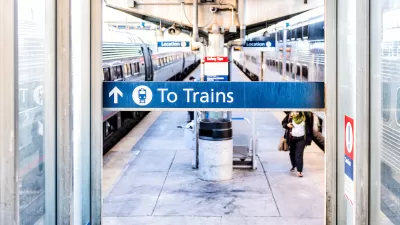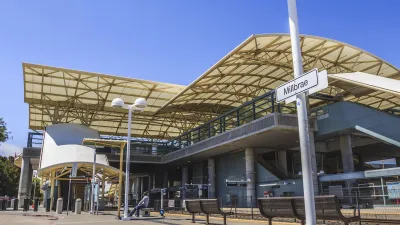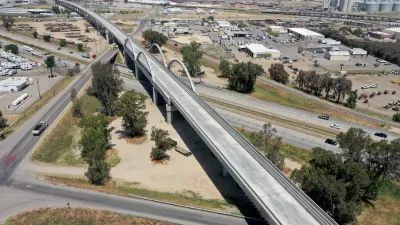If state lawmakers can agree to support matching funds for the project, California's high-speed rail could compete for $36 billion in new federal grants.

The $36 billion in federal high-speed rail grants passed in the infrastructure bill could help California accelerate its high-speed rail project, writes Roger Rudick. "For some perspective on California’s ability to compete for federal high-speed rail funds: in 2009, California’s project was awarded $3.5 billion from an $8 billion federal high-speed rail package. And that was when the project was still just a bunch of blueprints," Rudick says.
The project, currently under construction in California's Central Valley, has faced delays and opposition from lawmakers who disagree with the planned route or want the funds spent on improving local transit instead, obstructing state funding needed to match federal grants. According to Rudick,
That’s why the biggest remaining challenge to completing the project is the Democrat majority state legislature. Assemblymembers Anthony Rendon and Laura Friedman, ironically, don’t seem to want the project to ever reach their own constituents in Los Angeles. Currently, they are holding up over $4 billion in voter-approved bond money for the project, which was allocated by Governor Newsom but rejected by these legislators.
Rudick calls for state legislators to support high-speed rail and release the funds needed to move the project forward, commit to electric trains, and compete for a slice of the new federal funding.
FULL STORY: Feds Pass Downpayment for Next Phase of California High-Speed Rail

Trump Administration Could Effectively End Housing Voucher Program
Federal officials are eyeing major cuts to the Section 8 program that helps millions of low-income households pay rent.

Planetizen Federal Action Tracker
A weekly monitor of how Trump’s orders and actions are impacting planners and planning in America.

Ken Jennings Launches Transit Web Series
The Jeopardy champ wants you to ride public transit.

Washington Legislature Passes Rent Increase Cap
A bill that caps rent increases at 7 percent plus inflation is headed to the governor’s desk.

From Planning to Action: How LA County Is Rethinking Climate Resilience
Chief Sustainability Officer Rita Kampalath outlines the County’s shift from planning to implementation in its climate resilience efforts, emphasizing cross-departmental coordination, updated recovery strategies, and the need for flexible funding.

New Mexico Aging Department Commits to Helping Seniors Age ‘In Place’ and ‘Autonomously’ in New Draft Plan
As New Mexico’s population of seniors continues to grow, the state’s aging department is proposing expanded initiatives to help seniors maintain their autonomy while also supporting family caregivers.
Urban Design for Planners 1: Software Tools
This six-course series explores essential urban design concepts using open source software and equips planners with the tools they need to participate fully in the urban design process.
Planning for Universal Design
Learn the tools for implementing Universal Design in planning regulations.
Heyer Gruel & Associates PA
Ada County Highway District
Institute for Housing and Urban Development Studies (IHS)
City of Grandview
Harvard GSD Executive Education
Toledo-Lucas County Plan Commissions
Salt Lake City
NYU Wagner Graduate School of Public Service





























